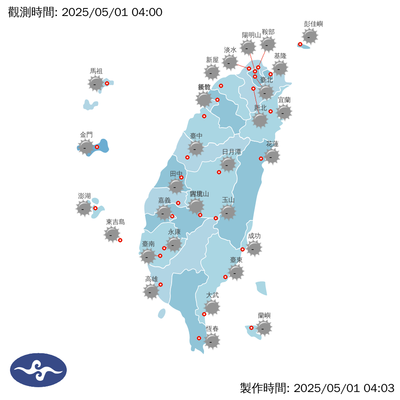(本英文簡介:感謝-阿里山國中小英文教師 邱雅莉 翻譯)
Introduction of Alishan Elementary and Junior High School
- History:
The predecessor of Alishan Elementary and Junior High School is Lalauya
Elementary School. Alishan Township was the only one which had no junior high school in Chiayi County after Siang-Lin Junior High School was closed down. Therefore, the townsmen advocated adding a junior high school to Lalauya Elementary School and renamed it Alishan Elementary and Junior High School. The preparatory office was set up on August 1, 2007. Soon afterwards, construction started on October 5, 2008 and the school was finally established on August 1, 2009.
- Operation:
Founded on August 1, 2009, both elementary and junior high schools started operating immediately. At first, the junior high school students took classes in Min-Ho Junior High School since the schoolhouses of junior high school were still under construction. The students came back to school on September 28, 2009 and studied in prefabricated houses until the buildings were completed in December.
- Transformation:
Alishan Township is mainly an indigenous territory of Cou. To conserve the traditional culture of the aborigines and achieve the goal of competency-based 12-year compulsory education, the school transformed into an indigenous experimental education school, with the development of aboriginal curriculum to start.
- Scale:
It is a typical small-scale, extremely remote school, including 3 classes at junior high school, 6 classes at elementary school, and 1 class at kindergarten, with 111 students in total. Located in Lalauya of Alishan Township, at an altitude of 1206m, the school is the center of transportation and administration of Alishan region. Tribes are concentrated here, owning substantial cultural resources, such as environment, ecology and industry.
- Administrative center:
Located at Lalauya, the school is the core region of Alishan Township and possesses rich cultures. With the advancement of time, however, various cultures have been integrated for swift information dissemination and frequent communication. Traditional culture is the local basis so cultural conservation demands immediate attention. As the educational base, the school retains ancient tradition and is regarded as the center of mental belief for local people. The campus is opened for residents to experience the aboriginal atmosphere. Based on the original culture, landscape, ecosystem and curriculum, in the future, the school will keep the principles of innovation and revival to flourish and prosper for years to come.
- Characteristic buildings:
█ Pavilion:
There are three kinds of traditional Cou pavilions, including tataka, hʉfʉ, and kuba. The pavilion in the school is a tataka which was designed by WANG, YI-FU, the chieftain of Tefuye, and CHEN, ZHONG-MING, a retired principal. It was built by the clansmen of Dabang, led by MAO, JHONG-SIN. Plenty of knowledge was passed on to students during the construction. Also, the relationship among people, land, and history became even closer by the time the pavilion was completed.
█ Platform:
The platform at the school is particularly denominated “ Lalauya ” which signifies maples, representing the school located in Lalauya Village.
█ Murals:
Various frescos can be seen on the campus, narrating the antique Cou cultures. All of the works were derived from a ZHUANG villager. People can quickly realize the special traditions of Cou through the murals.
- Curriculums:
█ Formal curriculum:
Regardless of the middle or elementary school, their frequency of Chinese, English, Math, Social Studies and Science courses is no different from a regular school down the mountain. Therefore, you can simultaneously participate in the regular curriculum as well as learning the unique Cou’s culture, which you cannot find anywhere else.
█ Cultural curriculum of Cou:
The Cou cultural courses are included in the school curriculum in addition to general subjects. These courses involve making chopsticks with bamboos, learning one of the steps of making traditional clothing- tanning, swidden agriculture, etc. Hopefully, the students can keep and pass on the culture to future generations.
- Activities:
█ Elementary school:
As the only Cou curriculum school in Chiayi, the sixth grade students will experience the Warrior Camp that lasts three days. Accompanied by hunters, the students use the natural resources to make chopsticks, pitch hunter huts, picnic outdoors, learn vegetation, make traps and take hunter paths to learn survival skills and experience the hunters’ life.
█ Junior high school:
Evening Hunting is held for the students of junior high school. The related knowledge such as the taboo of the forest, the animal habitus, the influence of wind on scents will be taught by the huntsmen while hunting. The students can closely observe hunting, flaying and dismembering to know more about the hunting culture if they luckily encounter prey in the mountains.





 縣長蒞臨縣長蒞臨
縣長蒞臨縣長蒞臨 901-09陳伯源製901-09陳伯源製
901-09陳伯源製901-09陳伯源製 901陳雅涵製901陳雅涵製
901陳雅涵製901陳雅涵製 90107莊答娜製90107莊答娜製
90107莊答娜製90107莊答娜製 90103方莛製90103方莛製
90103方莛製90103方莛製 901陳允浩製901陳允浩製
901陳允浩製901陳允浩製 90111陳欣悅製90111陳欣悅製
90111陳欣悅製90111陳欣悅製 90107莊答娜製90107莊答娜製
90107莊答娜製90107莊答娜製 90106蔡尚員製90106蔡尚員製
90106蔡尚員製90106蔡尚員製 90102 石宜仙製90102 石宜仙製
90102 石宜仙製90102 石宜仙製 90103 方莛製90103 方莛製
90103 方莛製90103 方莛製 90105陳允浩製90105陳允浩製
90105陳允浩製90105陳允浩製 90109陳伯源製90109陳伯源製
90109陳伯源製90109陳伯源製 90111陳欣悅製90111陳欣悅製
90111陳欣悅製90111陳欣悅製 90108鄭凱明製90108鄭凱明製
90108鄭凱明製90108鄭凱明製 基金會董事長交接基金會董事長交接
基金會董事長交接基金會董事長交接 70101石鈺玲70101石鈺玲
70101石鈺玲70101石鈺玲 70102周宣蓉70102周宣蓉
70102周宣蓉70102周宣蓉 80103陳彥霖製作80103陳彥霖製作
80103陳彥霖製作80103陳彥霖製作 80115楊侑稜製作80115楊侑稜製作
80115楊侑稜製作80115楊侑稜製作 80107劉奕聖製作80107劉奕聖製作
80107劉奕聖製作80107劉奕聖製作 80104黃品翊製作80104黃品翊製作
80104黃品翊製作80104黃品翊製作 80111詹真儒製作80111詹真儒製作
80111詹真儒製作80111詹真儒製作 80109洪巧薰製作80109洪巧薰製作
80109洪巧薰製作80109洪巧薰製作 70103高羽恩70103高羽恩
70103高羽恩70103高羽恩 70104楊靜書70104楊靜書
70104楊靜書70104楊靜書 70105安宥林70105安宥林
70105安宥林70105安宥林 學校簡介-鄒語...
學校簡介-鄒語...








